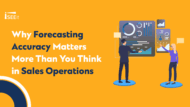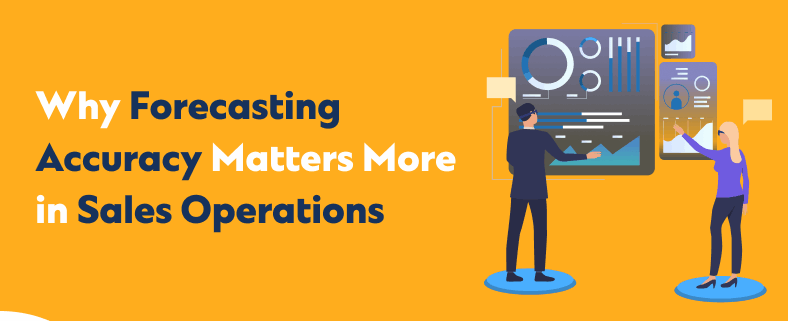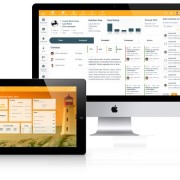Why Forecasting Accuracy Matters More Than You Think in Sales Operations

“The signal is the truth. The noise is what distracts us from the truth.”
— Nate Silver, The Signal and the Noise
In the ever-evolving world of sales, forecasting isn’t just about numbers, but it’s about the survival of the fittest. As Nate Silver points out, the real challenge lies in distinguishing real trends from random fluctuations to ensure forecasting accuracy. In today’s era of digital transformation, where AI and big data automation dominate, forecasting accuracy is no longer optional; it’s essential.
But here’s the elephant in the room:
How do you achieve 99% sales forecast accuracy in a world flooded with data and constant change?
Let’s do a step-by-step breakdown.
To implement a data-driven strategy or business predictions, your forecasting needs to be accurate. This will work as a supportive ladder to reach your required set targets. Enter a strategic sales forecasting tool that is customizable for your industry to predict future sales. But such tools are ancient history, as they are not sufficient to keep up with today’s targets.
Today, you need a multi-layered forecasting system that caters to all sales KPIs, such as customer demand, product performance, and market trends. But it doesn’t stop there; it must also intervene in the major sales bifactors, such as creating a well-planned sales workforce, financial budgeting, and marketing strategies alignment. In layman’s terms, the main goal here is to sync the sales operational and strategic plans, and only high forecast accuracy can ensure that.
Why You Can’t Rely on Gut Instinct Anymore?
Whether you are a startup or an MNC, your top sales decision-makers should understand the nitty-gritty involved in qualifying the sales forecast accuracy. As this is not child’s play, you can’t just assume data based on traditional strategies such as sales manager experiences or random in-house manual strategies that slow down the entire sales process. Instead, the sales manager must create informed paths, allocate sales resources wisely, and outmaneuver uncertainty. This is how you can ensure that your forecast accuracy metrics predictions are 99% reliable.
What’s at Stake with Inaccurate Forecasting?
To keep up with the latest big data analytics, machine learning, and AI technologies, there are multiple sales forecasting tools out there to correctly estimate the future ROI. Adopting such advanced technologies, sales reps no longer need to rely on guesswork or avoid it, thinking it some sort of mystical complex practice that can be addressed later on. Which is the complete opposite direction of the tricks and tips on how to calculate forecast accuracy to precisely set realistic sales targets. This helps create a financial budget to support the sales marketing on goings in creating targeted campaigns.
If you are still not convinced, here is the real story about the biggest players that have gone through extreme downfalls due to incorrect sales forecasting:
Cisco Systems: One such example is infamous tech giant Cisco, who faced direct financial damage of a $2.2 billion inventory write-down in 2001 due to demand overestimation. This was caused by wrong sales forecast accuracy, which affected the company’s market credibility.
BlackBerry: Once a dominant force in the smartphone market, BlackBerry faced a severe downfall, which was on every tongue in the early 2010s. This resulted in a significant market share loss and left the company with huge debt and excess inventory.
Well, these weren’t just random flukes, but they are an apt example of failing to read the signal through the noise.
Wondering what it takes to avoid such major data forecasting blunders?
- With the Strategic Blueprint, Say Goodbye to Outdated Methods – First thing first, stop relying on outdated methods like gut instinct, spreadsheets, or isolated CRM data, which won’t cut it anymore.
- Collect High-Quality Data from Multiple Sources – The company should collect high-quality data from a wide range of data sources to build reliable forecasts.
- CRM systems (Salesforce, HubSpot, Zoho) for sales histories
- ERP systems for operational data insights
- Point of Sale (POS) systems are used to analyze current sales trends.
- Market research reports for industry-specific trends
- Field sales reports from sales representatives on customer interactions
- Customer feedback data through surveys, reviews, and interviews for customer preferences
- Competitive analysis to examine competitors’ strategies and market positioning
- Economic data indicators (GDP, unemployment rates, and consumer spending patterns) for insightful interpretation.
- Social media analysis for industry trends, regulatory changes, and technological advances.
3. Use Advanced, Multi-Layered Forecasting Models – You require a data-driven, multi-layered forecasting strategy that aligns with your business sales objective. Using the right methodology will help you calculate and evaluate forecast accuracy metrics, enabling data-driven decisions.
The No#1 Roadblock that Hampers Your Sales Forecast Strategies within Seconds
The ideal sales require cross-functional collaboration, but in reality, due to a clash of opinions, there is always an internal tug-of-war between various sales teams. Here the solution will be to clearly establish guidelines for in-depth sales reports. But you must be wondering what the common denominators are to build accurate sales forecasts and overcome the sales industry hurdles.
a) Gathering historical sales data from the past analysis to identify trends and seasonal fluctuations for accurate predictions.
b) Market analysis for current market trends, such as consumer behavior and preferences, to anticipate market shifts and adjust sales strategies accordingly.
c) Identifying industry drivers to understand external influences such as technological changes, regulatory developments, and economic conditions.
d) Current sales pipeline evaluation to review if the ongoing deals are hot, cold, or warm to predict overall sales team performance.
e) AI-powered predictive analysis based on complex data patterns for an automated, data-driven sales forecast.
A Quick Checklist for Building a Reliable Sales Forecast
The above step-by-step methodology wouldn’t work if your sales forecasting software quality is low or below average.
1) Invest in a Strong CRM
With popular Customer Relationship Management (CRM) like Zoho Corporation, Salesforce, Pipedrive, and HubSpot CRM, sales teams tackle reporting, lead generation, communication, and automation all with the single platform. The most layman technique to segregate if you are using a decent CRM system is to check the ROI, but there are other parameters that can top-up or bottom-down your sales:
· Lead Management: Score and prioritize leads from various sources such as forms, emails, and social media based on customer behavior.
· Contact & Account Management: Centralized database to track customer communication history and their preferences.
· Pipeline & Opportunity Tracking: Assign tasks to team members with automated reminders and follow-ups.
· Communication Tools: Helps integrate with email, phone, or chat to keep track of historical data such as call logs.
· Reporting & Analytics: Monitor team performance and KPIs by identifying bottlenecks and areas for improvement.
· Automation: Automate repetitive tasks such as email sequences and deal updates to save time and maintain consistency.
2) What’s the Typical Timeline for Forecasting Tools Implementation: Days or Weeks?
Though this factor might not look like much of a deal to the outsider, it can turn out to be a deal breaker if the software is not implemented on time. Ideally, the timeline should depend upon your company’s type or size. But the main factor is that it should seamlessly integrate into your tech stack and should complement your sales team from the get-go.
3) Methodology Type Used for Sales Forecasting
If you have been in sales for ages, you probably might have heard about these most common sales forecasting methods, like trend analysis, regression analysis, time series analysis, and causal analysis.
All in all, if you want to break bread with the competitors in today’s fast-growing digital landscape. In this case, your sales team completely needs to get rid of your back-of-the-napkin ways. In today’s reality, selling has become more complex than ever, requiring full coverage of the entire sales cycle, from evaluating the demand generation campaign’s performance to tracking the ways you are landing prospects, such as phone calls, emails, or messages.
Why Your CRM Alone Isn’t Enough?
Yes, your CRM is great for tracking customer relationships. But when it comes to forecasting accuracy, they fall short. This is where you need a powerful accelerator with your traditional CRM tools to push you in the right direction.
One such tool is iSEEit Opportunity Manager, which complements traditional CRM like Salesforce or HubSpot, whose basic workflow is to track customer data, interactions, and deals, which is more focused on the ongoing processes. iSEEit, on the other hand, tackles the big picture, such as visualizing your sales workflows, defining your qualification criteria, and internal processes to deliver precise forecasts.
The integration of your in-house CRM with iSEEit, a B2B SaaS-based tool, helps users instantly identify the gaps in their sales forecast. But it doesn’t stop there, as this can quickly align all sales reps, first-line sales managers, executive management, and sales ops on the same page. This way, organizations can take preemptive action to close more deals.
What iSEEit Brings to the Table That Makes It Outshine Your Sales Forecast?
In the most layman terms, think of your CRM as the engine and iSEEit as the GPS, as it maps out the clearest path to closing deals.
- Visual Deal Qualification: Know instantly where each deal stands based on MEDDIC criteria.
- Real-Time Forecasting Dashboards: Get a 360° view of the pipeline, complete with deal health, next steps, and risk alerts.
- Seamless Integration with CRMs: No need to toggle between tools; iSEEit lives inside your CRM.
- Team Alignment: Everyone from SDRs to VPs sees the same metrics, so there’s no more guesswork during pipeline reviews.
Forecasting Accelerators That Actually Work
Let’s simplify what often seems complex. Here are the most widely used sales forecasting methods each with unique strengths:
- Trend Analysis: Uses historical data to identify long-term sales patterns.
- Regression Analysis: Predicts sales based on variables like marketing spend or seasonal trends.
- Time Series Analysis: Analyzes data points collected over time for recurring patterns.
- Causal Analysis: Looks at cause-and-effect relationships (e.g., price change impacts sales).
The best part? With tools like iSEEit, you don’t need to run these calculations manually. The platform combines historical data with your real-time pipeline activity to generate insights instantly. Gone are the days of constantly asking yourself, ‘How do I calculate forecast accuracy?’ with this swift iSEEit implementation.
Don’t Just Forecast; Strategize for Right Sales Forecasting Tools Implementation
Sales forecasting isn’t just creating a reliable strategy to steer your business in the right direction. But how fast and efficiently your team can adopt forecast accuracy metrics often comes down to implementation.
Though some tools take weeks to integrate, iSEEit seamlessly connects with your current CRM software and complements your tech stack, aligns with your team’s workflow, and doesn’t slow down your operations. And voila, you will see insights within days, not months.
Real-World Proof: 90% Forecast Accuracy with iSEEit
Let’s revisit some astonishing real-time stats from companies like Venatas and Mirakl, who used iSEEit to improve their sales accuracy.
Steve Reid, CEO of Venatas, uses iSEEit to operationalize MEDDIC within Salesforce, which empowered their clients to create cohesive, data-driven sales teams. This helped them, who are now achieving forecast accuracy rates of up to 90%.
Meanwhile, Brendan Walsh of Mirakl quoted, “Don’t show up to a Deal Clinic if your MEDDIC and iSEEit aren’t up to date —Brendan Walsh.” He further shared his real-time insights on how they use iSEEit to create a unified sales language to maintain consistency in their decision-making and resource planning, from sales engineers to account executives.
Conclusion: Forecasting Is Strategy, Not Just Reporting
Let’s be honest, the question “How to improve sales forecasting accuracy?” isn’t just a side query, but it’s the actual backbone of every sales strategy. If you want to outsmart your competitors, align your team, and consistently hit targets, you need more than a spreadsheet or a basic CRM dashboard. You need to ditch guesswork and embrace forecast accuracy metrics like iSEEit. A smart, data-driven accelerator is not just your best ally; it helps detect high-risk deals early, set realistic targets, align resources efficiently, and deliver results your leadership can count on.












